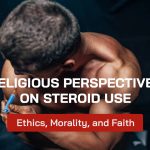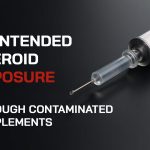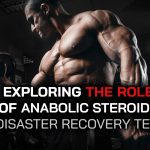Your basket is currently empty!
Category:
Steroids and Bodybuilding Injuries: Understanding the Link and Impact on Athlete Health
November 16th, 2024 by anabolicpointIn the world of professional bodybuilding, athletes continually push their bodies to the limit, striving to develop the most impressive physiques through rigorous training regimens, strict diets, and, for many, the use of anabolic steroids. These performance-enhancing drugs (PEDs) are known to accelerate muscle growth, strength, and recovery. However, while steroids may improve physical performance, they also introduce a significant risk of injuries, both during training and in the long-term.
Steroid use in bodybuilding is a double-edged sword, offering undeniable physical benefits, but also raising the risk of severe injuries and long-lasting health issues. Understanding how steroids influence the body, how they can contribute to injuries, and how athletes can mitigate these risks is crucial for anyone involved in bodybuilding—whether as an amateur or a professional.
The Role of Steroids in Bodybuilding
Steroids are synthetic substances designed to mimic the effects of naturally occurring hormones like testosterone, which plays a central role in muscle development, recovery, and fat loss. In bodybuilding, anabolic steroids are used to promote rapid muscle growth, enhance strength, and speed up recovery from intense training. These benefits make steroids appealing for bodybuilders who are trying to achieve an extreme level of muscle mass and definition.
Despite the significant benefits, steroids can have negative side effects that impact the musculoskeletal system and overall body health. The relationship between steroid use and bodybuilding injuries is complex, as steroids can influence muscle, tendon, and joint health in ways that increase the risk of damage, strain, and long-term injury.
How Steroids Impact Muscles and Joints
Anabolic steroids increase the production of proteins within muscle cells, facilitating faster and more pronounced muscle growth. This helps athletes build mass quickly, but muscle growth doesn’t necessarily correspond with the same level of strength or flexibility in tendons, ligaments, and joints. This imbalance between muscle size and tendon strength is a key factor in understanding why steroid users often suffer from more frequent and severe injuries.
- Muscle Growth vs. Tendon Strength
Steroids promote muscle hypertrophy—an increase in the size of muscle fibers—without directly affecting tendon and ligament strength. Tendons, which connect muscles to bones, do not grow at the same rate as muscles, making them more susceptible to tears and injuries. A bodybuilder who increases muscle mass significantly through steroid use may find that their tendons cannot handle the additional stress, which results in strains or tears. - Joint Health and Mobility
Steroid use also affects the body’s production of collagen, a protein that helps keep joints healthy and flexible. Steroids can reduce the production of collagen, leading to weaker joints and a greater chance of injury. Bodybuilders may notice that their joints feel less stable, especially when lifting heavy weights or performing intense movements. The additional weight and muscle mass can place increased pressure on the joints, making them more prone to wear and tear. - Water Retention and Increased Stress
Many anabolic steroids, such as Dianabol and Anadrol, can cause the body to retain excess water. This water retention can make the muscles appear larger but can also create added stress on the joints. The extra fluid can increase pressure on joints like the knees, elbows, and shoulders, leading to inflammation, discomfort, and a higher likelihood of injury during lifting or strenuous physical activity.
Types of Injuries Common in Steroid-Using Bodybuilders
Bodybuilders using steroids face an increased risk of several specific types of injuries. These injuries often stem from the combination of rapid muscle growth and the additional strain placed on the body’s tendons, ligaments, and joints.
- Tendon Tears and Strains
As mentioned earlier, muscles grow faster than tendons when steroids are used, leading to an increased risk of tendon injuries. Bodybuilders who experience tendon tears, particularly in the shoulders, elbows, and knees, may find themselves sidelined for weeks or even months, potentially hindering their ability to compete or train effectively. - Rotator Cuff Injuries
The rotator cuff, a group of muscles and tendons in the shoulder, is commonly injured in steroid-using bodybuilders. The excessive weight lifting combined with the rapid muscle growth in the upper body increases stress on the shoulder joints, which can result in tears or strains. Rotator cuff injuries are notorious for being difficult to recover from and can severely limit a bodybuilder’s ability to train. - Knee and Elbow Joint Damage
With the increased muscle mass and strength from steroids, bodybuilders often lift heavier weights, which can put excessive pressure on the knee and elbow joints. Injuries such as tendonitis, bursitis, and tears in the meniscus or ligaments are common in steroid users who focus on heavy squats, deadlifts, and other compound movements that involve the lower body. - Lower Back Strains
The lower back is another area prone to injury in steroid users due to the sheer amount of weight lifted. Steroids can increase muscle strength, but this often results in lifting weights that exceed the body’s structural limitations. Bodybuilders who do not take adequate precautions or use proper form may suffer from lower back strains or herniated discs. - Chronic Joint Pain and Arthritis
Long-term steroid use can lead to chronic joint pain due to the decreased production of collagen. Joint instability and wear and tear can lead to conditions such as arthritis. Bodybuilders may also experience persistent joint pain, stiffness, and swelling as a result of the wear and tear caused by lifting heavy weights over extended periods. - Increased Risk of Overtraining
While steroids enhance muscle recovery, they can also mask the symptoms of overtraining. Athletes may push their bodies too far without feeling the immediate consequences, leading to overuse injuries. This is because steroids can suppress fatigue, allowing bodybuilders to train harder and longer than they otherwise might, potentially resulting in strain and injury.
Preventing Injuries While Using Steroids
While the risks associated with steroid use and bodybuilding injuries are significant, they are not unavoidable. There are several strategies that athletes can adopt to minimize the likelihood of injury while using anabolic steroids:
- Proper Training Techniques
Ensuring proper form and technique during weightlifting is crucial. Lifting with poor form, especially when pushing heavy weights, places additional strain on the muscles and joints. Bodybuilders should consider working with an experienced coach to refine their technique and avoid placing unnecessary stress on vulnerable areas like the knees, shoulders, and back. - Gradual Progression in Weight Lifting
While steroids can accelerate muscle growth, it’s important not to rush the process of increasing weights. Progress should be gradual to allow the tendons and ligaments to catch up with the muscle growth. Lifting weights that the body is not prepared for will increase the risk of injury, even for steroid users. - Joint Support Supplements
Many bodybuilders use joint support supplements, such as glucosamine, chondroitin, and fish oil, to maintain joint health while using steroids. These supplements help support cartilage health and improve the body’s ability to recover from joint stress. Additionally, maintaining a healthy diet rich in vitamins and minerals, especially those that promote joint health, can reduce the risk of injury. - Rest and Recovery
Even with the enhanced recovery properties of steroids, rest is still vital for injury prevention. Overtraining can lead to strain, fatigue, and long-term damage to muscles and joints. Bodybuilders should prioritize rest days and avoid excessive training that could lead to burnout or injury. Stretching and foam rolling can also help relieve muscle tension and improve flexibility. - Incorporate Mobility and Flexibility Training
Stretching and mobility work should be an integral part of any steroid user’s training regimen. Improving joint mobility and muscle flexibility can help reduce the risk of injuries. By ensuring that muscles and tendons are flexible and well-prepared for intense activity, bodybuilders can avoid strains and tears. - Use of Post-Cycle Therapy (PCT)
After completing a steroid cycle, it is essential for athletes to undergo Post-Cycle Therapy (PCT) to help restore natural hormone levels and support overall recovery. A proper PCT regimen can help prevent joint pain and muscle degeneration, providing bodybuilders with the best opportunity to maintain their strength and flexibility.
Frequently Asked Questions
- Do steroids make injuries worse?
Yes, steroids can exacerbate injuries by promoting rapid muscle growth without corresponding tendon and ligament strength. This imbalance increases the risk of strains and tears. - What are the most common injuries among steroid-using bodybuilders?
Tendon tears, rotator cuff injuries, knee and elbow joint damage, lower back strains, and chronic joint pain are among the most common injuries. - How can bodybuilders reduce the risk of injuries while using steroids?
Proper training techniques, gradual progression in lifting weights, joint support supplements, and prioritizing rest are key factors in reducing injury risk. - Can steroids lead to long-term joint damage?
Yes, long-term steroid use can decrease collagen production, leading to weaker joints and an increased risk of chronic conditions like arthritis. - Why are steroid users more prone to tendon injuries?
Steroids promote rapid muscle growth but do not increase tendon strength at the same rate, leading to an imbalance that makes tendons more susceptible to tears. - How does water retention from steroids affect joint health?
Excess water retention can place additional stress on the joints, leading to inflammation and an increased risk of injury during heavy lifting. - Can steroid use cause overuse injuries?
Yes, steroids can mask fatigue and allow bodybuilders to train harder than they should, leading to overuse injuries such as tendinitis and muscle strains. - Is stretching important for steroid users?
Yes, stretching and mobility exercises are vital for maintaining joint health and reducing the risk of injuries due to muscle imbalances. - Do steroids improve muscle recovery but worsen injury recovery?
Steroids enhance muscle recovery but can lead to slower recovery for tendons, ligaments, and joints, increasing the risk of long-term injuries. - Can a proper PCT help prevent joint injuries after a steroid cycle?
Yes, Post-Cycle Therapy (PCT) can support overall recovery, including joint health, by restoring natural hormone levels and promoting healing.
Moving Forward: Mitigating Risks and Fostering Health
While anabolic steroids offer considerable benefits in bodybuilding, they come with a host of potential risks and long-term consequences for the body. The relationship between steroid use and injuries is undeniable, but by adopting precautionary measures such as proper training, rest, and joint support, athletes can reduce their risk and optimize their performance. It is important to recognize the potential dangers and make informed decisions about steroid use, ensuring that bodybuilders prioritize their long-term health while pursuing their competitive goals.
The Long-Term Effects of Steroid Abuse in Bodybuilding: A Comprehensive Analysis
November 16th, 2024 by anabolicpointBodybuilding is a sport that demands exceptional levels of dedication, discipline, and resilience. For many athletes, achieving the pinnacle of muscular development requires rigorous training and a meticulously planned diet. However, some turn to anabolic steroids as a shortcut to accelerate their progress. While steroids may offer rapid gains in muscle mass and strength, their abuse often leads to a range of long-term consequences that affect physical health, mental well-being, and overall quality of life.
This article explores the long-term effects of steroid abuse in bodybuilding, highlighting the risks associated with prolonged use, the physiological and psychological impacts, and the broader implications for the bodybuilding community. By understanding these effects, athletes can make more informed choices about their health and fitness journeys.
The Role of Steroids in Bodybuilding
Anabolic steroids are synthetic derivatives of testosterone, designed to enhance muscle growth, improve strength, and speed up recovery. These substances are used both medically, for conditions like muscle-wasting diseases, and non-medically, by athletes seeking an edge in performance or aesthetics. In bodybuilding, steroids are often abused at doses far exceeding therapeutic levels, leading to significant health risks.
Bodybuilders who abuse steroids often aim to achieve extreme levels of muscularity and definition, goals that can feel unattainable through natural means alone. While the initial results may seem impressive, the long-term consequences of steroid abuse are often irreversible and far-reaching.
Long-Term Physical Effects of Steroid Abuse
Hormonal Imbalances and Endocrine Disruption
One of the most significant consequences of steroid abuse is the disruption of the body’s natural hormone production. Prolonged use of anabolic steroids suppresses the hypothalamic-pituitary-gonadal (HPG) axis, leading to decreased production of natural testosterone. This suppression can result in conditions such as:
- Hypogonadism: Characterized by low testosterone levels, hypogonadism can cause fatigue, reduced libido, infertility, and muscle loss.
- Gynecomastia: The conversion of excess testosterone into estrogen can lead to the development of breast tissue in men, a condition often requiring surgical correction.
Cardiovascular Complications
Steroid abuse has severe implications for cardiovascular health. Long-term use increases the risk of:
- Atherosclerosis: Elevated levels of low-density lipoprotein (LDL) cholesterol and reduced high-density lipoprotein (HDL) cholesterol promote the formation of arterial plaques.
- Hypertension: Steroids can raise blood pressure, increasing the risk of heart attacks and strokes.
- Heart Enlargement: Prolonged abuse may lead to left ventricular hypertrophy, a condition where the heart muscle thickens and becomes less efficient.
Liver Damage
Oral anabolic steroids are particularly harmful to the liver, as they are metabolized in this organ. Long-term use can result in liver conditions such as:
- Cholestasis: Impaired bile flow, leading to jaundice and liver damage.
- Liver Tumors: Steroid abuse increases the risk of benign and malignant liver tumors.
- Hepatotoxicity: General liver toxicity, which can lead to liver failure.
Musculoskeletal and Tendon Injuries
Rapid muscle growth induced by steroids often outpaces the development of tendons and ligaments, making them prone to injuries. Over time, this imbalance can lead to chronic pain, tears, and reduced mobility.
Skin and Hair Changes
Steroid abuse frequently causes acne, oily skin, and male-pattern baldness. While these effects may seem superficial, they are often permanent and can contribute to emotional distress.
Psychological Effects of Long-Term Steroid Abuse
Mood Disorders and Aggression
Steroids are notorious for causing mood swings and irritability, a phenomenon often referred to as “roid rage.” Long-term abuse is associated with more severe psychological issues, including:
- Depression: The suppression of natural testosterone can lead to depressive symptoms, particularly when users stop using steroids.
- Anxiety: Steroid-induced changes in brain chemistry may trigger anxiety disorders.
- Addiction: Many users develop a psychological dependency on steroids, feeling unable to maintain their physique or self-esteem without them.
Cognitive Decline
Research suggests that prolonged steroid abuse may negatively impact cognitive function, leading to difficulties with memory, decision-making, and concentration.
Body Dysmorphia
Body dysmorphic disorder (BDD) is common among steroid users. This condition involves an obsessive focus on perceived physical flaws, often driving users to continue abusing steroids despite the risks.
Social and Ethical Implications
The long-term effects of steroid abuse extend beyond the individual, influencing their relationships and social dynamics. Behavioral changes such as aggression and irritability can strain personal relationships, while the stigma associated with steroid use may lead to isolation or judgment from peers.
Ethically, the use of steroids in competitive bodybuilding undermines fair play and creates an uneven playing field. Athletes who compete naturally often face disadvantages, while those who use steroids may grapple with feelings of guilt or dishonesty.
Steroid Dependency and the Challenges of Quitting
Dependency is a common outcome of long-term steroid abuse. Physical dependency arises from the suppression of natural hormone production, making it difficult for users to stop without experiencing withdrawal symptoms. These symptoms may include:
- Fatigue: Extreme tiredness due to low testosterone levels.
- Depression: Emotional lows caused by hormonal imbalances.
- Loss of Muscle Mass: A significant concern for bodybuilders who fear losing their hard-earned gains.
Psychological dependency is equally challenging, as users often struggle to redefine their self-worth and identity without steroids. The fear of regression in performance or appearance perpetuates the cycle of abuse.
Prevention and Recovery: A Balanced Approach
Preventing steroid abuse in bodybuilding requires education, awareness, and the promotion of healthy alternatives. Coaches, trainers, and organizations play a crucial role in fostering an environment that prioritizes long-term health over short-term gains.
For those seeking to recover from steroid abuse, a combination of medical intervention, therapy, and support networks is essential. Post-cycle therapy (PCT) can help restore natural hormone production, while counseling addresses the psychological aspects of dependency. Building a supportive community of peers and professionals can also aid in the recovery process.
Questions and Answers About Steroid Abuse in Bodybuilding
- What are the long-term health risks of steroid abuse?
Long-term risks include cardiovascular disease, liver damage, hormonal imbalances, infertility, and psychological disorders. - Can the effects of steroid abuse be reversed?
Some effects, such as hormonal imbalances, can be managed with medical intervention, but others, like liver damage and virilization, may be permanent. - Why do bodybuilders abuse steroids?
Bodybuilders abuse steroids to enhance muscle growth, improve strength, and achieve competitive advantages. - Is steroid dependency treatable?
Yes, steroid dependency can be treated with medical support, therapy, and lifestyle adjustments, but the process requires commitment and time. - What are the psychological effects of steroid abuse?
Steroid abuse can lead to mood swings, aggression, depression, anxiety, and body dysmorphic disorder. - How do steroids affect natural testosterone production?
Steroids suppress the hypothalamic-pituitary-gonadal axis, leading to reduced natural testosterone production and potential infertility. - Can natural bodybuilding be as effective as steroid-enhanced bodybuilding?
While natural bodybuilding may take longer, it offers sustainable results without the risks associated with steroids. - Are oral steroids more dangerous than injectable ones?
Oral steroids pose a higher risk of liver toxicity, but both forms carry significant health risks when abused. - How can bodybuilders prevent steroid dependency?
Education, realistic goal-setting, and a focus on natural methods can help prevent dependency. - What support is available for those recovering from steroid abuse?
Recovery resources include medical professionals, therapists, support groups, and post-cycle therapy programs.
A New Perspective on Bodybuilding
Steroid abuse in bodybuilding offers a cautionary tale about the pursuit of perfection at any cost. While steroids may provide short-term gains, their long-term effects often lead to irreversible health issues, psychological challenges, and diminished quality of life. For athletes, the journey to success should prioritize sustainability, health, and integrity.
By embracing natural methods, setting realistic goals, and fostering a supportive community, bodybuilders can redefine success and achieve their aspirations without compromising their future. The sport of bodybuilding has the potential to inspire and empower, but only when approached with a balanced and informed perspective.
Most Common Steroids Used in Mr. Olympia Competitions: A Detailed Insight into the World of Elite Bodybuilding
November 16th, 2024 by anabolicpointThe Mr. Olympia competition, one of the most prestigious bodybuilding events in the world, showcases the pinnacle of physical development. Athletes who compete in this event must adhere to extremely high standards of muscle mass, symmetry, and conditioning. To achieve such an extraordinary level of physique, many top-tier bodybuilders turn to anabolic steroids and other performance-enhancing substances. Despite the fact that these substances are banned by most bodybuilding organizations, their usage continues to be a prominent, albeit controversial, part of the sport.
Anabolic steroids, which are synthetic derivatives of testosterone, have long been associated with bodybuilding. These substances can enhance muscle growth, increase strength, and accelerate recovery—traits that are essential for competitors aiming to perform at the highest level. However, the use of steroids also raises serious health risks and ethical concerns. This article will explore the most common steroids used in Mr. Olympia competitions, how they affect the bodybuilders who use them, and the broader implications for the sport of bodybuilding.
The Role of Steroids in Mr. Olympia Competitions
Steroids are a cornerstone in bodybuilding, particularly at the professional level. The use of steroids in Mr. Olympia competitions is a well-known and frequently discussed topic. While these substances are not openly advertised by competitors or coaches, many athletes use them to enhance their performance. Bodybuilders competing in the Mr. Olympia event undergo rigorous training programs and strict nutritional regimens, but steroids provide an additional edge that is hard to overlook in a competition where marginal gains can make the difference between victory and defeat.
At the highest levels of bodybuilding, achieving a massive, sculpted physique that looks incredibly symmetrical and dry—meaning minimal water retention—requires not only genetics and hard work but also assistance from substances that can aid in muscle growth, fat loss, and recovery. Steroids are a significant part of this equation, and their use is often discussed in bodybuilding forums, gyms, and training camps across the globe.
Most Common Steroids Used by Mr. Olympia Competitors
There is a wide range of anabolic steroids that bodybuilders incorporate into their training cycles. These steroids serve various purposes, including bulking, cutting, and maintaining a high level of strength. Below are some of the most commonly used steroids among Mr. Olympia competitors:
- Dianabol (Methandrostenolone)
Known as one of the most potent anabolic steroids, Dianabol is a go-to for many bodybuilders looking to increase their muscle mass rapidly. It is particularly popular during bulking phases because it enhances protein synthesis and promotes muscle growth. Competitors often use it at the beginning of their training cycles to get the initial gains that provide a foundation for further development. Its effectiveness, however, comes with side effects such as water retention and liver toxicity. - Testosterone (Various Esters like Enanthate, Cypionate, Propionate)
Testosterone is the base of many steroid cycles, as it is the naturally occurring hormone that anabolic steroids are derived from. Different esters of testosterone, such as Testosterone Enanthate or Testosterone Cypionate, are used to increase overall muscle mass and strength. Testosterone is also instrumental in maintaining high energy levels and recovery rates during intense training sessions. This steroid is often utilized in both bulking and cutting cycles depending on the dosage and combination with other compounds. - Trenbolone (Trenbolone Acetate, Trenbolone Enanthate)
One of the most powerful anabolic steroids, Trenbolone is favored for its ability to increase muscle density, fat loss, and strength. It is especially prized during the cutting phase when bodybuilders aim to retain as much lean muscle mass as possible while reducing body fat. Trenbolone increases the body’s nitrogen retention, boosting protein synthesis and muscle growth. However, its use is not without risks, including potential cardiovascular problems, aggression, and night sweats. - Anadrol (Oxymetholone)
Anadrol is known for producing rapid gains in size and strength, making it a popular choice for bodybuilders during bulking cycles. It works by increasing red blood cell production, which improves the delivery of oxygen to the muscles, enhancing endurance and strength. However, Anadrol is notorious for causing water retention and liver stress, so it is often used for short periods and in combination with other steroids that help mitigate these effects. - Winstrol (Stanozolol)
Winstrol is a fast-acting anabolic steroid often used during the cutting phase of a bodybuilding cycle. Bodybuilders rely on Winstrol to maintain muscle mass while reducing body fat and achieving a hard, dry look. It is known for its ability to enhance vascularity and promote fat burning. Winstrol can also increase strength without adding significant weight, making it ideal for athletes who need to maintain or even lower their body weight while enhancing muscle definition. It is often used in combination with other steroids to achieve a lean, shredded appearance. - Deca-Durabolin (Nandrolone Decanoate)
Deca-Durabolin is another popular steroid among professional bodybuilders, primarily because of its ability to enhance muscle growth and recovery. It is often stacked with other steroids during bulking cycles to help athletes pack on mass without excessive water retention. Nandrolone has a reputation for being relatively mild compared to other steroids, but it still offers substantial benefits in terms of muscle development, joint relief, and overall recovery. Some bodybuilders also use Deca-Durabolin during cutting phases to help preserve muscle mass while dieting. - Masteron (Drostanolone Propionate)
Masteron is often used during the cutting phase of bodybuilding competitions due to its ability to reduce fat while enhancing muscle hardness and vascularity. Masteron has anti-estrogenic properties, which helps keep estrogen-related side effects at bay, such as water retention and gynecomastia (male breast enlargement). This steroid is prized for its ability to enhance muscle density, making it ideal for bodybuilders preparing for a show. It is frequently used in combination with other steroids like Winstrol or Trenbolone for maximum results. - HGH (Human Growth Hormone)
Human Growth Hormone is not a steroid but is often used in conjunction with anabolic steroids to promote muscle growth and fat loss. HGH helps stimulate the production of insulin-like growth factor 1 (IGF-1), which is responsible for promoting cell growth and muscle repair. Many top-tier bodybuilders use HGH to support long-term muscle gains, improve recovery, and enhance their physique’s overall aesthetic appearance. HGH is particularly effective when used alongside steroids for improved muscle density and fat loss. - Clenbuterol
Although not an anabolic steroid, Clenbuterol is a powerful fat-burning compound often used by bodybuilders during cutting cycles. Clenbuterol works by increasing the body’s metabolic rate, promoting fat loss while preserving lean muscle mass. Bodybuilders often turn to Clenbuterol to help shed the last bit of stubborn fat before a competition, helping them achieve a shredded, contest-ready physique. It is often used alongside steroids like Winstrol or Trenbolone to enhance fat-burning effects. - Proviron (Mesterolone)
Proviron is a mild anabolic steroid used by bodybuilders to enhance their physique while minimizing estrogenic side effects. It is often used during cutting phases to help maintain a dry look by reducing water retention. Proviron also helps increase the body’s testosterone levels, making it an effective addition to cycles where testosterone levels may dip. While not as powerful as some of the other steroids mentioned, Proviron plays a key role in improving muscle density and definition, making it popular among bodybuilders in the final stages of competition preparation.
The Risks and Side Effects of Steroid Use in Mr. Olympia Competitions
The use of anabolic steroids in bodybuilding, while offering significant performance benefits, comes with numerous risks and side effects. The intense training and strict dieting required for Mr. Olympia competitions, combined with steroid use, can take a toll on the body and mind.
Some of the potential side effects of steroid use in bodybuilding include:
- Liver Damage: Many anabolic steroids, especially oral ones like Dianabol and Anadrol, can be toxic to the liver when used for prolonged periods.
- Cardiovascular Issues: Steroids can lead to high blood pressure, increased risk of heart disease, and negative changes in cholesterol levels.
- Hormonal Imbalances: The use of steroids can disrupt natural testosterone production, leading to low testosterone levels and other hormonal imbalances. This may cause issues such as gynecomastia (breast tissue enlargement in men), reduced sperm production, and infertility.
- Psychological Effects: Steroid use has been linked to mood swings, aggression (sometimes referred to as “roid rage”), anxiety, and depression.
- Kidney Damage: Some steroids, particularly those taken in high doses, can lead to kidney stress and damage.
- Joint and Tendon Problems: While steroids help build muscle mass, they may not provide the same strength to tendons and ligaments, potentially leading to injuries.
The Ethics and Legality of Steroid Use in Bodybuilding
The use of anabolic steroids in bodybuilding competitions, including the Mr. Olympia event, raises significant ethical and legal questions. While many professional bodybuilders use steroids to achieve their physique, the use of these substances is not only banned by most bodybuilding organizations but also illegal in many countries without a prescription. The ethics of steroid use is a contentious issue in the sport, with critics arguing that it undermines fair competition and places athletes at significant health risks.
Some argue that steroid use is an unfortunate but necessary part of the sport, given the extreme demands of bodybuilding. However, others believe that natural bodybuilding, where athletes do not use performance-enhancing drugs, should be the standard. This debate continues to evolve as more and more bodybuilders use steroids to push the boundaries of human physical potential.
Frequently Asked Questions
- What steroids are commonly used in Mr. Olympia competitions?
Some of the most commonly used steroids include Dianabol, Testosterone, Trenbolone, Anadrol, Winstrol, Deca-Durabolin, and Masteron. - How do steroids enhance a bodybuilder’s performance?
Steroids help increase muscle mass, improve recovery, enhance strength, and reduce body fat, giving athletes an edge in training and competition. - Are steroids legal in bodybuilding competitions?
No, anabolic steroids are banned in most bodybuilding competitions, including Mr. Olympia, due to their performance-enhancing effects and health risks. - What are the side effects of steroid use?
Side effects can include liver damage, cardiovascular issues, hormonal imbalances, psychological effects like aggression, and kidney damage. - Can natural bodybuilding compete with steroid-enhanced bodybuilding?
While natural bodybuilding is possible, competing with steroid-enhanced athletes at the highest levels like Mr. Olympia is difficult due to the significant advantages provided by steroids. - How do bodybuilders manage the side effects of steroids?
Many bodybuilders use additional supplements or medication to manage side effects, such as using aromatase inhibitors to prevent estrogenic effects or undergoing post-cycle therapy (PCT) to restore hormone levels. - Do all Mr. Olympia competitors use steroids?
While most top-tier competitors use steroids, some opt for natural bodybuilding and compete in different categories. - Is there a way to improve bodybuilding performance without steroids?
Yes, proper training, nutrition, rest, and natural supplements like protein powders, creatine, and BCAAs can help enhance muscle growth and performance. - Can steroid use lead to permanent health problems?
Yes, prolonged steroid use can cause lasting damage to organs, including the liver, kidneys, and heart, and can also result in hormonal imbalances and fertility issues. - What is the future of steroid use in bodybuilding?
As testing and regulations become stricter, there may be a shift toward more natural bodybuilding competitions, but steroid use is likely to remain a part of elite bodybuilding for the foreseeable future.
Final Reflections: Striving for Balance in Bodybuilding
Steroid use in Mr. Olympia competitions is an undeniable reality of modern bodybuilding. While the substances provide immense physical benefits, they also bring health risks and ethical concerns. The ongoing dialogue about steroid use continues to shape the future of bodybuilding, with a growing emphasis on athlete well-being and fair competition. As the sport evolves, it is crucial to find a balance between achieving exceptional results and safeguarding the health of those who strive to reach the pinnacle of bodybuilding excellence.
Female Bodybuilders and Steroid Use: Exploring the Realities and Risks
November 16th, 2024 by anabolicpointFemale bodybuilding is a unique and demanding discipline that combines strength, aesthetics, and dedication. Achieving an exceptional level of muscle definition and size requires a rigorous training regimen, disciplined nutrition, and often years of commitment. However, in the pursuit of these goals, some female bodybuilders turn to anabolic steroids to enhance their progress. Steroid use among female athletes is a controversial topic, raising questions about health, ethics, and the pressures of competitive bodybuilding.
This article delves into the use of steroids by female bodybuilders, exploring the motivations behind their use, the physiological and psychological effects, and the associated risks. It also addresses the broader implications of steroid use in women’s bodybuilding, including societal perceptions and the challenges of maintaining balance between athletic ambition and health.
The Role of Steroids in Female Bodybuilding
Steroids, particularly anabolic-androgenic steroids (AAS), are synthetic derivatives of testosterone that promote muscle growth, strength, and recovery. While steroids are predominantly associated with male athletes, female bodybuilders also use them to achieve extreme muscularity and enhanced performance. The pressures of competition and the desire to achieve an idealized physique often drive women to consider steroid use, despite the known risks.
Steroids provide several benefits to female bodybuilders, including increased muscle mass, improved recovery, and enhanced endurance. However, these benefits come with significant trade-offs, especially for women whose hormonal and physiological profiles differ greatly from men.
Motivations Behind Steroid Use Among Female Bodybuilders
The decision to use steroids is influenced by various factors, including personal goals, competitive pressures, and cultural influences. Some of the common motivations include:
- Competitive Edge: At the highest levels of competition, achieving the muscularity and definition required to win often seems unattainable without chemical assistance.
- Breaking Plateaus: Many athletes turn to steroids when they feel they have reached a training plateau and want to accelerate progress.
- Societal Pressures: Media and societal expectations about body image can influence women to pursue extreme physiques, sometimes through steroid use.
- Validation and Recognition: For some, the pursuit of recognition and validation within the bodybuilding community outweighs the potential risks of steroids.
Physiological Effects of Steroids on Women
Steroids affect women differently than men due to variations in hormonal composition. While the anabolic effects of steroids—such as increased muscle size and strength—are similar, the androgenic effects are more pronounced in women. These effects include the development of masculine traits, which can sometimes become irreversible with prolonged use.
Key physiological changes associated with steroid use in women include:
- Virilization: Virilization refers to the development of masculine traits, such as a deepened voice, facial and body hair growth, and an enlarged clitoris. These changes are often irreversible.
- Hormonal Imbalances: Steroids disrupt the natural balance of estrogen and testosterone, leading to irregular menstrual cycles, infertility, and reduced natural hormone production.
- Muscle Growth: While steroids significantly enhance muscle mass and definition, the rapid growth can sometimes strain tendons and ligaments, increasing the risk of injuries.
- Skin and Hair Issues: Acne and oily skin are common side effects, along with potential hair thinning or baldness.
Psychological Effects of Steroid Use
The psychological impact of steroid use on female bodybuilders is profound. While steroids can enhance confidence and energy in the short term, prolonged use often leads to psychological challenges:
- Mood Swings: Steroids are known to cause irritability, aggression, and mood swings, sometimes referred to as “roid rage.”
- Body Dysmorphia: The pursuit of an idealized physique can lead to body dysmorphic disorder, where individuals perceive their bodies as inadequate despite objective progress.
- Dependency: The psychological reliance on steroids to maintain performance or physique can lead to dependency, making it difficult for users to stop.
Risks and Long-Term Consequences of Steroid Use
The risks of steroid use for female bodybuilders are significant and multifaceted. Beyond the immediate side effects, long-term use can have serious consequences for physical and mental health.
- Cardiovascular Issues: Steroids increase the risk of high blood pressure, heart disease, and cholesterol imbalances, which can have life-threatening implications.
- Liver Damage: Oral steroids, in particular, are hepatotoxic and can cause liver damage or failure with extended use.
- Reproductive Health: Steroid use can lead to infertility, reduced libido, and permanent disruption of menstrual cycles.
- Mental Health Challenges: Prolonged use is associated with depression, anxiety, and addictive behaviors.
Steroid Use in Competitive Bodybuilding
Steroid use is a controversial but prevalent issue in competitive bodybuilding, including women’s divisions. While some federations enforce strict anti-doping policies, others operate in untested environments where steroid use is tacitly accepted or even expected.
This creates an uneven playing field, where natural athletes often struggle to compete against enhanced competitors. For female bodybuilders, this dynamic adds to the pressure to use steroids, particularly in divisions where extreme muscularity is rewarded.
Societal Perceptions of Female Bodybuilders and Steroid Use
Female bodybuilders who use steroids face unique societal challenges. The physical changes caused by steroids, particularly virilization, often lead to stigmatization and judgment. These women may be criticized for deviating from traditional notions of femininity or face accusations of cheating.
However, there is also a growing movement to celebrate muscular women and challenge outdated stereotypes. Female athletes who speak openly about their choices, including the risks and challenges of steroid use, contribute to a broader conversation about gender, performance, and health.
Alternatives to Steroid Use
For female bodybuilders seeking to achieve their goals without the risks of steroids, there are alternatives that prioritize long-term health and sustainable progress:
- Optimized Nutrition: Tailoring macronutrients and supplements to individual needs can maximize natural muscle growth and recovery.
- Innovative Training Methods: Incorporating varied training techniques, such as progressive overload and periodization, can help break plateaus.
- Legal Supplements: Products such as branched-chain amino acids (BCAAs), creatine, and protein powders offer safe and effective support for muscle development.
Addressing Steroid Use in Women’s Bodybuilding: A Path Forward
Steroid use among female bodybuilders is a complex issue rooted in the pressures of competition, societal expectations, and personal ambition. Addressing this issue requires a multifaceted approach:
- Education: Promoting awareness of the risks and long-term consequences of steroid use is essential for informed decision-making.
- Support Networks: Providing access to coaches, nutritionists, and mental health professionals can help athletes achieve their goals without resorting to steroids.
- Celebrating Diversity: Expanding definitions of strength and beauty in bodybuilding can reduce the pressure to conform to extreme ideals.
Questions and Answers About Female Bodybuilders and Steroid Use
- Why do female bodybuilders use steroids?
Female bodybuilders use steroids to enhance muscle growth, strength, and recovery, often driven by competitive pressures or personal goals. - What are the side effects of steroids in women?
Side effects include virilization, hormonal imbalances, acne, hair loss, and reproductive health issues. - Are the effects of steroids reversible in women?
Some effects, such as voice deepening and clitoral enlargement, are often irreversible, even after stopping steroids. - Do all female bodybuilders use steroids?
No, many female bodybuilders compete and train naturally, but steroid use is more common in untested divisions. - How do steroids affect women’s mental health?
Steroids can lead to mood swings, aggression, body dysmorphia, and psychological dependency. - Can women use lower doses of steroids to avoid side effects?
While lower doses may reduce risks, there is no guarantee of avoiding side effects, and even small doses can cause harm. - What are the long-term risks of steroid use in women?
Long-term risks include cardiovascular disease, liver damage, infertility, and mental health challenges. - Are there safer alternatives to steroids for female bodybuilders?
Yes, alternatives include optimized nutrition, innovative training methods, and legal supplements. - How can female bodybuilders avoid societal judgment?
By fostering open conversations about choices and celebrating diverse definitions of femininity and strength, athletes can challenge stigmas. - What role do competitions play in steroid use among women?
Competitive pressures, particularly in untested divisions, significantly influence the decision to use steroids.
Redefining Strength and Success
Female bodybuilders who use steroids navigate a challenging landscape of physical, mental, and societal complexities. While steroids can provide short-term advantages, the long-term risks and consequences often outweigh the benefits.
By embracing natural methods, prioritizing health, and celebrating diversity in strength and physique, female bodybuilders can set new standards for success. The future of women’s bodybuilding lies in empowering athletes to pursue their goals authentically, without compromising their well-being.
Legal Issues Surrounding Steroid Use in Bodybuilding Competitions: A Comprehensive Overview
November 16th, 2024 by anabolicpointSteroid use in bodybuilding competitions has been a topic of significant controversy and debate for many years. The allure of achieving an extraordinary physique quickly and efficiently through the use of anabolic steroids has enticed many athletes. However, these performance-enhancing substances come with serious legal, health, and ethical implications that affect not only the individual athlete but also the integrity of the sport itself.
Anabolic steroids, synthetic derivatives of the male sex hormone testosterone, are known for their ability to rapidly increase muscle mass, strength, and endurance. They are widely used across various sports, including bodybuilding, to gain a competitive edge. Despite their effectiveness, anabolic steroids are banned in most professional and amateur bodybuilding competitions due to their potential to create an unfair advantage and the significant health risks they pose. This article explores the legal landscape surrounding steroid use in bodybuilding competitions, the consequences for athletes caught using them, and the policies and regulations governing these substances in the sport.
The Legal Status of Steroid Use in Bodybuilding Competitions
The legality of anabolic steroid use varies by country and the level of competition. However, most bodybuilding organizations, including well-known bodies like the International Federation of Bodybuilding and Fitness (IFBB) and the World Anti-Doping Agency (WADA), prohibit the use of anabolic steroids. These organizations enforce strict anti-doping policies to ensure a level playing field for all competitors and protect the athletes’ health.
Steroid use is classified as illegal in many countries without a prescription. In the United States, anabolic steroids are classified as a Schedule III controlled substance under the Anabolic Steroid Control Act of 1990. This means that possessing, distributing, or using steroids without a prescription is a federal offense. Penalties for illegal steroid use can include criminal charges, fines, and even jail time.
Steroid Use in Professional and Amateur Bodybuilding Competitions
In professional bodybuilding, steroid use is widespread, despite being banned by organizations like WADA and the IFBB. Many athletes turn to anabolic steroids to enhance their performance, build muscle mass, and increase strength to meet the aesthetic and competitive standards of the sport. However, steroid use at the professional level is often masked by the extensive use of other substances like diuretics, growth hormone, and insulin, making it difficult to detect through drug testing.
For amateur bodybuilders, the temptation to use anabolic steroids is similarly strong, especially given the highly competitive nature of bodybuilding. The desire to gain a competitive edge or accelerate muscle growth can lead to the use of steroids, despite the legal risks involved. Many amateur athletes, especially those just starting out in the sport, may be unaware of the long-term legal and health implications of steroid use.
Legal Consequences of Steroid Use in Bodybuilding Competitions
The legal consequences of using steroids in bodybuilding competitions can be severe, ranging from disqualification from competitions to legal action and imprisonment, depending on the jurisdiction. In most professional bodybuilding competitions, athletes who test positive for steroids face immediate disqualification, loss of titles, and a ban from future events. This can significantly damage an athlete’s career, reputation, and financial prospects.
For example, in 2015, the IFBB issued a lifetime ban for several top athletes who tested positive for steroids, sending a clear message that the organization takes anti-doping rules seriously. Similar actions have been taken by other organizations, including the National Physique Committee (NPC), which also upholds strict policies against steroid use.
In addition to the athletic consequences, athletes caught using steroids in competitions can face legal repercussions. As mentioned earlier, anabolic steroids are classified as controlled substances in many countries, including the United States, where using or possessing them without a prescription is illegal. Athletes caught using steroids outside of legal frameworks can be subject to fines, legal fees, and even jail time.
Testing and Enforcement in Bodybuilding Competitions
One of the key ways that steroid use is regulated in bodybuilding competitions is through drug testing. Organizations such as WADA and the International Olympic Committee (IOC) have established anti-doping programs that include mandatory drug testing for athletes in various sports, including bodybuilding. These tests are designed to detect the presence of anabolic steroids and other performance-enhancing drugs in an athlete’s system.
Drug testing in bodybuilding is typically conducted through urine samples, although blood tests may also be used. The tests look for traces of banned substances, including anabolic steroids, human growth hormone (HGH), diuretics, and other compounds. The tests are random, meaning that athletes cannot anticipate when they will be tested. Positive test results can lead to disqualification from the competition, a suspension, or a ban from the sport altogether.
However, drug testing in bodybuilding has faced significant criticism. Many athletes and critics argue that the tests are often inadequate, given the sophisticated methods used by some bodybuilders to mask the presence of steroids in their system. For example, some athletes may use masking agents or employ “cycling” techniques, where they stop using steroids temporarily before a competition to avoid detection. These methods make it difficult to ensure fair competition and raise questions about the effectiveness of current anti-doping policies in bodybuilding.
The Ethics of Steroid Use in Bodybuilding Competitions
Beyond the legal consequences, steroid use in bodybuilding competitions raises ethical questions regarding fairness, safety, and integrity in the sport. At the heart of the debate is the issue of whether it is fair for athletes to use steroids to gain a competitive advantage. Critics argue that steroid use undermines the integrity of the sport and creates an uneven playing field, where those who do not use steroids are at a disadvantage.
Steroid use also raises concerns about the health risks to athletes. Bodybuilders who use steroids may suffer from a range of side effects, including liver damage, cardiovascular disease, infertility, psychological disorders, and hormonal imbalances. The long-term consequences of steroid use can be severe, and many bodybuilders who use steroids are at risk of serious health complications later in life. In light of these risks, the ethics of using steroids in bodybuilding competitions become even more controversial.
Moreover, there is the issue of the message that steroid use sends to younger athletes and aspiring bodybuilders. Many young athletes look up to professional bodybuilders as role models and may be influenced by their steroid-enhanced physiques. The use of steroids in bodybuilding competitions sends the message that success in the sport is not solely dependent on hard work, dedication, and natural talent, but also on the use of illegal and dangerous substances.
Legal Implications for Coaches and Support Staff
Steroid use in bodybuilding is not just a concern for the athletes themselves but also for coaches, trainers, and other support staff who may be involved in guiding athletes through their steroid cycles. In many countries, coaches and other support staff who assist athletes with obtaining or using steroids may face legal consequences, including criminal charges.
In 2005, several high-profile coaches in the United States were investigated for their involvement in providing steroids to athletes. These investigations led to arrests and legal actions against coaches and trainers who facilitated steroid use in sports. Coaches who are found to be directly involved in doping practices may face professional and legal repercussions, including loss of their coaching licenses, career damage, and potential jail time.
The Future of Steroid Regulations in Bodybuilding
As bodybuilding continues to evolve, so too will the regulations surrounding steroid use. While many organizations have adopted stricter drug-testing policies, there is still much work to be done to ensure fair competition and athlete safety. Some critics argue that bodybuilding organizations need to invest more in research and testing technologies to detect steroids more effectively, while others call for a reevaluation of the role steroids play in the sport.
In recent years, some bodybuilding organizations have even proposed allowing steroid use in competition under controlled circumstances. Proponents of this approach argue that it could help level the playing field by eliminating the need for athletes to cheat or hide their use of steroids. However, this controversial proposal has been met with strong opposition from those who believe that steroid use is detrimental to the sport and should remain banned.
Frequently Asked Questions About Steroid Use and Legal Issues in Bodybuilding Competitions
- Is steroid use legal in bodybuilding competitions? In most bodybuilding organizations, steroid use is prohibited. Steroids are classified as controlled substances in many countries, making their use without a prescription illegal.
- What are the legal consequences of steroid use in bodybuilding? Athletes caught using steroids in bodybuilding competitions can face disqualification, suspension, or lifetime bans from the sport. Legal consequences may include fines, legal fees, and imprisonment in some jurisdictions.
- How are steroids detected in bodybuilding competitions? Steroid use is detected through drug testing, typically involving urine samples, to check for banned substances like anabolic steroids, human growth hormone, and diuretics.
- What happens if an athlete fails a drug test in bodybuilding? Athletes who fail a drug test may be disqualified from the competition, have their titles revoked, and face suspensions or bans from future competitions.
- Are there any bodybuilding organizations that allow steroid use? Most reputable bodybuilding organizations, including the IFBB and WADA, have strict anti-doping policies that prohibit steroid use. However, there is ongoing debate about whether steroid use should be allowed in bodybuilding.
- What health risks are associated with steroid use in bodybuilding? Steroid use can lead to liver damage, cardiovascular disease, infertility, hormonal imbalances, psychological issues, and other severe health complications.
- Can coaches be legally held responsible for steroid use in athletes? Yes, coaches and support staff who assist athletes in obtaining or using steroids may face legal consequences, including criminal charges and professional sanctions.
- What are some ethical concerns regarding steroid use in bodybuilding? Ethical concerns include fairness in competition, athlete safety, and the negative influence on younger athletes who may be encouraged to use steroids to achieve similar results.
- How can bodybuilding competitions maintain fairness without steroid use? Bodybuilding organizations can enforce stricter drug testing policies, improve testing technologies, and focus on promoting natural bodybuilding to ensure fair competition.
- What are the long-term consequences of steroid use in bodybuilding? Long-term steroid use can lead to significant health risks, including organ damage, hormonal imbalance, mental health disorders, and potentially lifelong medical complications.
Final Thoughts: The Ongoing Debate of Steroid Use in Bodybuilding Competitions
Steroid use in bodybuilding competitions remains one of the most contentious issues in the sport. While anabolic steroids offer significant performance-enhancing benefits, their use carries serious legal, ethical, and health risks. As the sport evolves, there is increasing pressure to address these issues and ensure that bodybuilding competitions are fair, safe, and free from illicit performance enhancement. Athletes, coaches, and organizations must continue to work together to create a regulatory framework that protects the integrity of the sport and the health of the athletes involved.
Risks of Steroid Dependency in Bodybuilders: Understanding the Challenges and Consequences
November 16th, 2024 by anabolicpointThe pursuit of a sculpted, muscular physique is a defining feature of bodybuilding. While dedication to training and nutrition forms the cornerstone of success, some individuals turn to anabolic steroids to amplify their results. Steroids promise rapid muscle growth, enhanced strength, and faster recovery. However, their use often comes with a darker side—dependency.
Steroid dependency in bodybuilders is a growing concern. This phenomenon involves both physical reliance, as the body becomes accustomed to the hormonal boost, and psychological dependency, driven by the fear of losing gains. This article explores the complexities of steroid dependency, its risks, and its impact on physical, mental, and social well-being.
Understanding Steroid Dependency
Anabolic steroids are synthetic derivatives of testosterone that promote muscle growth and strength. While they are effective for short-term enhancement, long-term or improper use can lead to dependency. Dependency occurs when bodybuilders feel unable to maintain their physique, performance, or self-esteem without continued steroid use.
Steroid dependency is fueled by several factors:
- Psychological Pressure: Bodybuilders often face immense pressure to meet or exceed aesthetic ideals, which can drive prolonged steroid use.
- Physical Adaptation: Extended steroid use suppresses natural testosterone production, making the body reliant on external hormones.
- Fear of Regression: Many users fear losing their hard-earned muscle gains if they stop using steroids, perpetuating a cycle of dependency.
How Dependency Develops in Bodybuilders
Dependency on steroids is rarely immediate. It typically evolves through several stages:
- Initial Experimentation: Many bodybuilders start using steroids to break through plateaus or prepare for competitions. Initial results are often dramatic, reinforcing the decision to continue use.
- Regular Use: Over time, users may increase doses or cycle lengths to maintain or enhance their results. At this stage, the body begins adapting to the presence of synthetic hormones.
- Emotional Attachment: Steroids become intertwined with the user’s identity and self-image. The idea of stopping may trigger anxiety or fear of losing muscle mass and strength.
- Physical Dependency: Prolonged use suppresses the body’s natural testosterone production. Stopping abruptly can lead to withdrawal symptoms, including fatigue, depression, and loss of muscle mass, making it difficult to quit.
Risks Associated with Steroid Dependency
Steroid dependency poses a wide array of risks, affecting not only physical health but also mental and social well-being. Some of the most significant risks include:
Physical Risks
- Hormonal Imbalances: Long-term steroid use suppresses the hypothalamic-pituitary-gonadal axis, leading to reduced natural testosterone production. This can result in hypogonadism, infertility, and difficulty maintaining muscle mass after cessation.
- Cardiovascular Issues: Steroid use elevates the risk of high blood pressure, cholesterol imbalances, and heart disease. Dependency exacerbates these risks due to prolonged use.
- Liver Damage: Oral steroids, in particular, are hepatotoxic and can lead to liver damage or failure over time.
- Skin and Hair Problems: Acne, oily skin, and hair loss are common side effects that can persist with long-term use.
- Musculoskeletal Injuries: Rapid muscle growth may strain tendons and ligaments, leading to injuries. Dependency increases exposure to these risks.
Psychological Risks
- Mood Swings: Steroids can cause irritability, aggression, and depression. Dependency often magnifies these psychological effects.
- Body Dysmorphia: Dependency is frequently linked to muscle dysmorphia, a condition where individuals feel their physique is never adequate, regardless of its objective appearance.
- Addictive Behaviors: Users often exhibit behaviors akin to other forms of addiction, including compulsive use despite adverse consequences.
Social and Ethical Implications
- Relationship Strains: Steroid dependency can lead to behavioral changes that strain personal and professional relationships.
- Legal Issues: In many countries, possessing or distributing anabolic steroids without a prescription is illegal. Dependency may push individuals toward illicit means of obtaining steroids.
Post-Cycle Therapy (PCT) and Its Role in Dependency
Post-cycle therapy (PCT) is a regimen designed to help users recover their natural hormone production after a steroid cycle. While PCT can mitigate some withdrawal symptoms, it is not a guaranteed solution for dependency.
For dependent users, the psychological attachment to steroids often outweighs the benefits of PCT. They may skip or misuse PCT in favor of continuing steroid use, further deepening their reliance on these substances.
The Psychological Cycle of Dependency
The psychological aspects of steroid dependency are complex. Users often feel trapped in a cycle of use, marked by:
- High Expectations: Steroid use raises expectations for rapid gains and peak performance, creating a cycle of striving for more.
- Fear of Loss: The fear of losing progress leads users to continue or increase dosages.
- Identity Crisis: For many, their muscular physique becomes a core part of their identity. The idea of stopping steroids feels akin to losing oneself.
This cycle is compounded by societal pressures and the glorification of extreme physiques in bodybuilding culture.
Long-Term Consequences of Dependency
Steroid dependency can have lifelong repercussions. Physically, it increases the risk of chronic health issues like cardiovascular disease, liver failure, and hormonal imbalances. Psychologically, it can lead to long-term mental health struggles, including depression and anxiety.
Socially, dependency can alienate users from family and friends, as behavioral changes and the prioritization of steroids over relationships take a toll.
Breaking Free from Steroid Dependency
Overcoming steroid dependency is challenging but possible. The process often involves:
- Medical Intervention: Endocrinologists can help manage hormonal imbalances and design tapering strategies to minimize withdrawal effects.
- Therapy and Counseling: Addressing the psychological aspects of dependency is critical. Cognitive-behavioral therapy (CBT) and support groups can be particularly effective.
- Education and Awareness: Understanding the risks of steroids and setting realistic fitness goals can help prevent and address dependency.
Support from peers, trainers, and family members is also vital in helping individuals transition away from steroid reliance.
Questions and Answers About Steroid Dependency
- What causes steroid dependency?
Dependency develops from prolonged use, psychological attachment, and suppressed natural testosterone production. Fear of losing muscle gains is a major driver. - Can steroid dependency be cured?
Yes, with medical support and therapy, individuals can recover from steroid dependency. However, the process requires commitment and patience. - What are the withdrawal symptoms of steroids?
Common symptoms include fatigue, depression, loss of appetite, reduced libido, and muscle loss. - Do all steroid users become dependent?
Not all users develop dependency, but prolonged or unsupervised use significantly increases the risk. - Is post-cycle therapy enough to prevent dependency?
PCT helps restore natural hormone production but does not address psychological dependency. Both aspects need to be managed. - How does steroid dependency affect mental health?
Dependency is linked to mood swings, aggression, depression, and body dysmorphia, all of which can persist even after stopping use. - Can natural bodybuilding help prevent dependency?
Embracing natural methods reduces the need for steroids and the risk of dependency while fostering sustainable fitness goals. - What are the long-term health risks of steroid dependency?
Risks include cardiovascular disease, liver damage, hormonal imbalances, and chronic mental health issues. - Can dependency lead to addiction?
Yes, steroid dependency often mirrors addictive behaviors, including compulsive use and withdrawal symptoms. - Are there safe alternatives to steroids?
Legal supplements, optimized training, and nutrition plans are safer ways to achieve fitness goals without the risks of steroids.
A Sustainable Path to Fitness
Steroid dependency in bodybuilders is a complex issue, rooted in physical, psychological, and cultural factors. While steroids may offer short-term benefits, the long-term consequences of dependency often outweigh the gains. Breaking free from dependency requires a holistic approach that addresses both the physical and mental aspects of reliance.
In the world of bodybuilding, sustainable fitness should always take precedence over shortcuts. By focusing on natural methods and fostering a balanced mindset, individuals can achieve their goals without compromising their health, relationships, or future.










